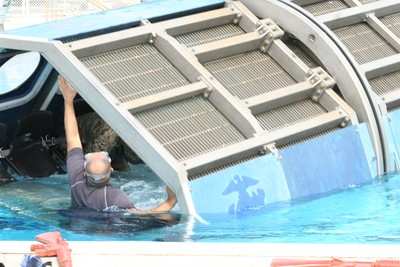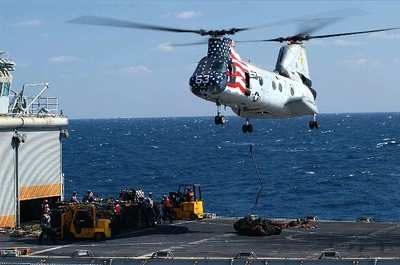Survival Systems USA Inc. has trained military personnel,
civilians and federal employees how to survive aircraft ditchings
for the last 25 years. Some Headquarters U.S. Marine Corps Forces,
Pacific Marines got their chance Aug. 20-22. Out of every 50,000
military flight hours, there is at least one helicopter ditching.
Survival Systems’ goal is to give military and civilians the
ability and confidence to use the training when lives are at
stake.
“The world is almost 80 percent water, and every time
someone flies over it, they stand a chance of that plane or
helicopter going down,” said Lesa Maiava, Survival Systems
instructor. “We want to eliminate that panic factor and build
confidence in our students. So when they have to ditch in a
worst-case scenario, they can reflect back to their training and
react quickly.”
According to Survival Systems, former students who later
survived an actual ditching said they have the most realistic
training facilities. Part of those facilities is a Modular
Amphibious Egress Trainer in the deep end of a 50-meter,
Olympic-size pool at Marine Corps Base Hawaii.
The MAET is made to resemble the Marine Corps’ CH-46E
(pictured below) and CH-53D helicopter cabins. To simulate a
helo-ditching in the water, it is lowered into the pool by a pulley
system that rotates it upside down after submerging. It has
push/pull exit windows and hatches that students must jettison and
exit during training.

“We have different models of MAETs that we can adapt to
resemble any aircraft for training purposes,” said Chris
Judah, Survival Systems USA Inc., representative. “The
purpose remains the same.”
They also provide training on how to survive after escaping the
aircraft to avoid death from exposure or drowning from exhaustion
by using life rafts or clinging to other survivors in the
water.
Survival Systems’ is headquartered in Connecticut, and
they have training facilities around the country for crew members
and passengers of any type of aircraft.
Survival Systems’ clientele includes major organizations,
such as Chevron Overseas Petroleum, Dateline NBC and Coca-Cola
Inc., the FBI and many law enforcement personnel who are likely or
will fly over water while serving in a work capacity.
The students learn to overcome their disorientation and fear to
successfully escape with a breath hold or using a small air tank.
Instructors are in the water with the students at all times for
safety and to assess the student’s performance.

Since Survival Systems began their contract with the Marine
Corps in 2002, more than 25,000 Leathernecks have completed the
training. On average they train 6,000 Army personnel and around
1,000 civilian employees each year.
“Out of the militaries, the Navy and Marine Corps are the
most enthusiastic about the program and are starting to demand more
Sailors and Marines complete the three-day course,” said
Hanna. “In respect to the military, it’s our way of
giving back and making troops that much more prepared.” [ANN
salutes Lance Cpl. Ethan Hoaldridge, Marine Forces Pacific, and
Cpl. Drew Hendricks]
 ANN's Daily Aero-Term (04.20.24): Light Gun
ANN's Daily Aero-Term (04.20.24): Light Gun Aero-News: Quote of the Day (04.20.24)
Aero-News: Quote of the Day (04.20.24) ANN's Daily Aero-Linx (04.21.24)
ANN's Daily Aero-Linx (04.21.24) Aero-News: Quote of the Day (04.21.24)
Aero-News: Quote of the Day (04.21.24) ANN's Daily Aero-Term (04.21.24): Aircraft Conflict
ANN's Daily Aero-Term (04.21.24): Aircraft Conflict




